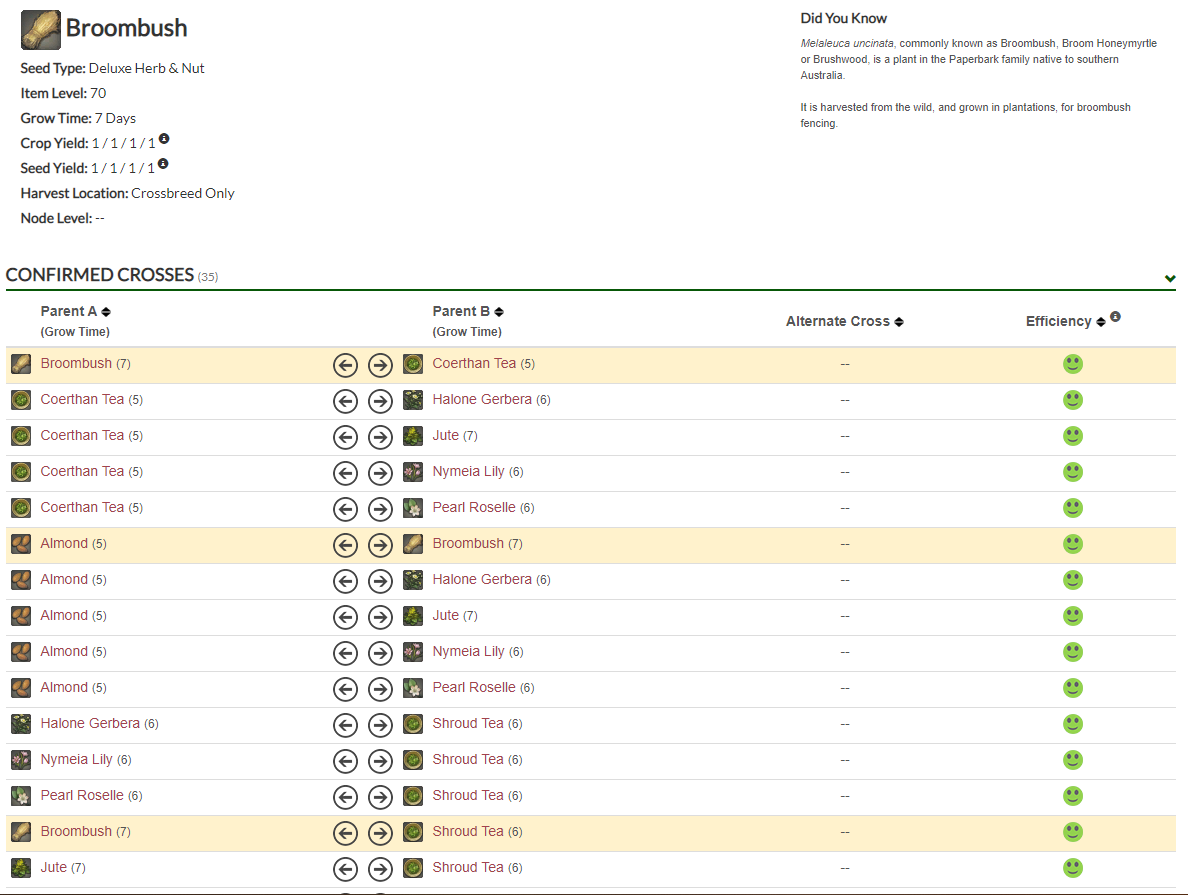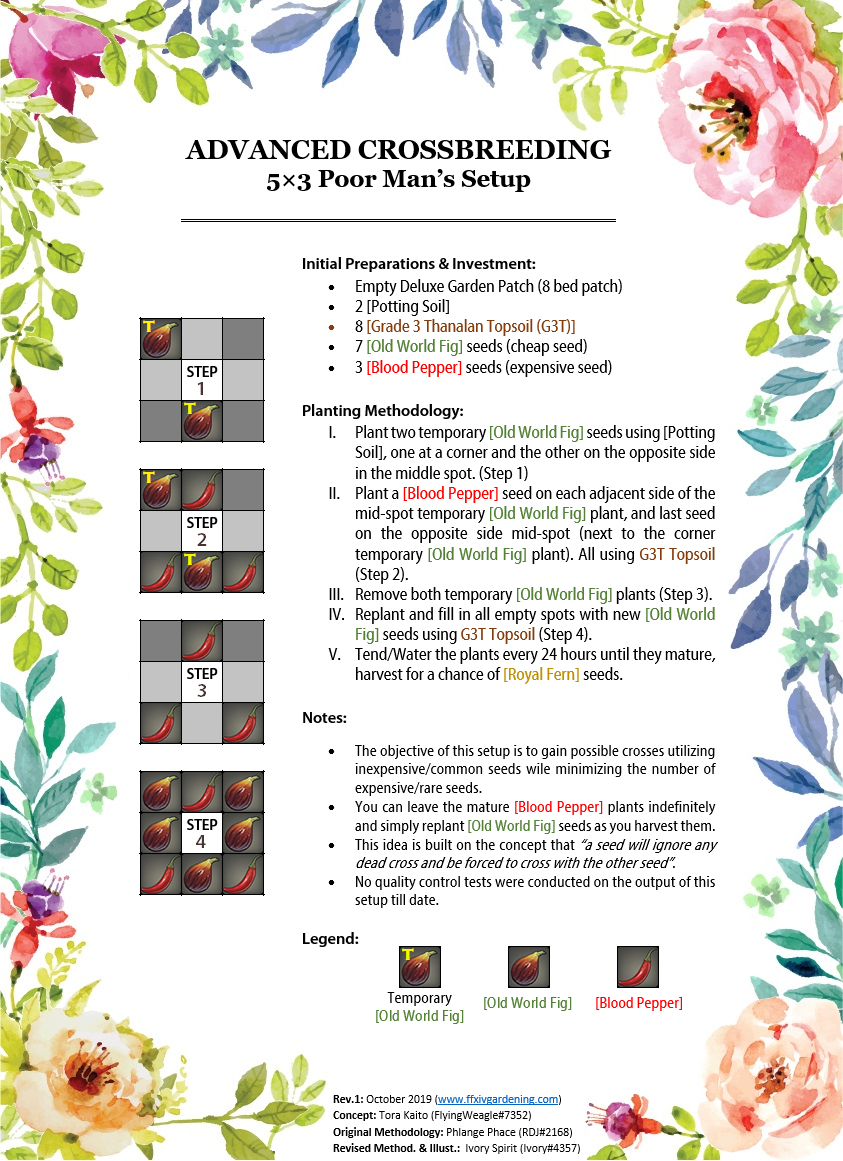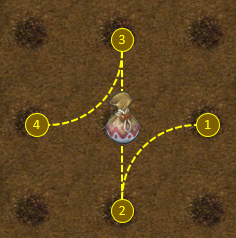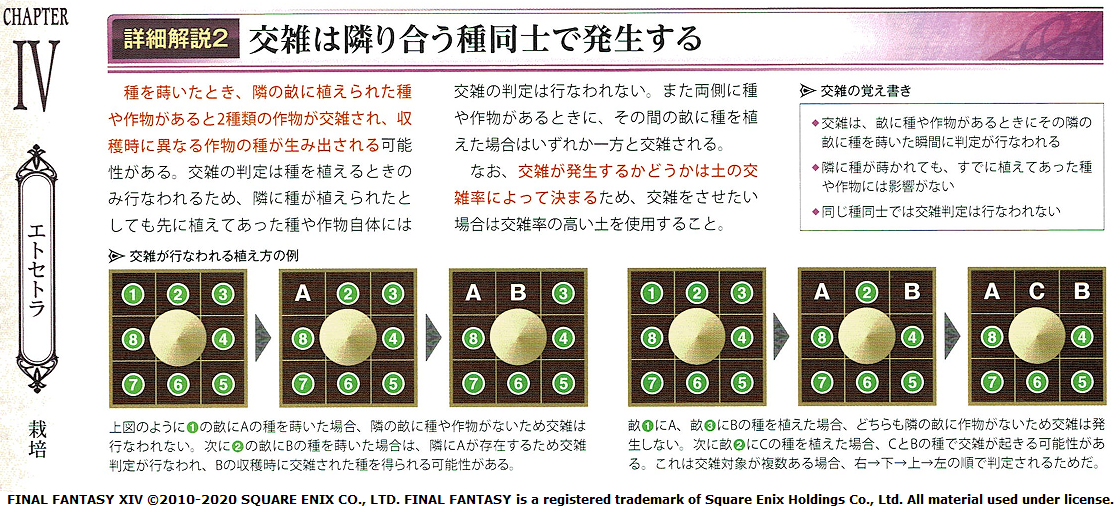GUIDE TO GARDENING
Be sure to check out the Video Tutorials
THE BASICS
There are two things that are required in order to have a successful garden: seeds and topsoil. Each bed can take 1 seed and 1 topsoil. A Deluxe Garden Patch with 8 beds will therefore hold up to 8 seeds and 8 topsoils. There are many different types of seeds, however, most of these seeds are not very useful since the plants are easy enough to gather by a botanist or obtain through a retainer. Gardening should therefore be used to crossbreed for seeds that are rare to find or even impossible to obtain otherwise.
Aside from seeds you will also need topsoil when planting your garden. There are three different types of topsoils, each with 3 different grades. The higher the grade, the more potent their effects. If you can gather or afford Grade 3 soils, then there is absolutely no reason to use Grades 1 or 2 of any soil type.
The first and most useful type of soil is Thanalan Topsoil which increases crossbreeding chance and will be used most of the time. The second type is Shroud Topsoil, which is used to increase yield quantity. Shroud soil can be used to harvest more plants per seed and even more seeds per harvest (there are a few plants that Shroud soil will not increase plant/seed yield: Blood Pepper, Broombush, Glazenut, Jute and Thavnairian Onion). The final soil type is La Noscean Topsoil which is used to increase the likelihood of obtaining high-quality plant yields (this has been deprecated and there's really no use for this anymore).
A majority of the time, crossbreeding will be involved, so Grade 3 Thanalan Topsoil will be used the most. It can be obtained in Hammerlea, Western Thanalan, at 5AM Eorzea Time. The Topsoil Gathering page will give you a full list of when and where you can harvest all soils.
Note that Grade 3 soils of any type can only be gathered by a miner. A miner retainer can also be sent out on ventures to bring back topsoil as well.
A successful garden also requires tending from time to time. An untended garden will lead to the loss of the plants. Plants need to be tended at least once a day to ensure that they are doing well, otherwise they will wilt (turn purple) and eventually wither (die). A few higher tier plants will need tended more often. When a plant is ready to be harvested it will stay that way indefinitely so you can keep in the ground if you wish.
You can also fertilize plants which will reduce grow times by approximately one Earth hour (with some exceptions). However, there is a limit to how much fertilizer you can use before it becomes ineffective. Please see the Fertilizer Analysis page for an in-depth discussion on the effects of fertilizer on plants.
CROSSBREEDING

Now for the most interesting aspect of gardening. Crossbreeding is the mechanic of generating an otherwise unobtainable seed by planting two different types of seeds beside each other. It is the mechanic that allows us to plant seeds and obtain new seeds such as Broombush, Royal Fern, Blood Pepper, Chive, Glazenut and more. When a plant is ready to be harvested, aside from the plant itself you may also find a crossbred seed.
You cannot obtain seeds by simply planting a seed and harvesting it. You are required to crossbreed in order to obtain seeds.
The linked screenshot shows many of the different crosses that can be used to obtain Broombush seeds. For example, planting a Coerthan Tea seed next to a Halone Gerbera seed (or vice-versa) will have a chance to yield a Broombush seed when harvesting either of the plants. The methodology for planting is explained in detail below under the Basic Crossbreeding section.
You will also notice some of the crosses are highlighted. This indicates the cross is a loop which means you can crossbreed a seed with itself to obtain more of the same seed. In this example, planting a Broombush seed next to a Coerthan Tea seed will have a chance to yield a Broombush seed when harvesting either of the plants.
Refer to the Site Documentation to understand how to read the crossbreed data shown on the site.
BASIC CROSSBREEDING

In most situations a single garden patch should only be used to crossbreed for one specific seed. There are some exceptions which can be found on the Cross Diagrams page. Assuming we have a Deluxe Garden Patch, and therefore we have 8 beds, then only 4 of each seed in a crossbreed pair can exist in a patch.
Crossbreeding occurs the moment a seed is planted. This means the first seed that is planted will not produce a crossbred seed since there was nothing next to it when planted.
The linked screenshot shows the most basic way to plant seeds in order to obtain a crossbred seed (view full size). It's usually referred to as the 4x4 cross and can be used in all crossbreed situations. This specific cross shows how to obtain Royal Kukuru seeds by crossing Old World Fig and Mirror Apple seeds.
Different plants have different growing times so you can use this to your advantage. For example, Glazenuts take a day longer to fully grow than Apricots. When the Apricots are ready full grown, harvest them and replace them with more Apricot Kernels. These kernels will eventually yield Glazenut Seeds because at the time of planting there should already be Glazenuts growing beside them.
The only time a bed should be empty is when the entire patch needs to be prepared to crossbreed a completely different seed. Otherwise, replacing plants as they are ready to be harvested will increase your rate of production. If all plants are ready to be harvested at the same time you can harvest the four plants of the same type and replant next to the other plants ready to be harvested. Doing so will allow the newly planted seeds to crossbreed with the harvestable plants. You can then harvest the remaining four plants and replant those seeds.
ADVANCED CROSSBREEDING

There are certain situations where you might want to change up the way you plant seeds depending on the availability and/or cost of certain seeds. This is called the 5x3 setup. There are two different setups associated with this method: the Poor Man's Setup and Rich Man's Setup.
The first screenshot shows the Poor Man's Setup (view full size). The objective of this is to gain possible crosses utilizing inexpensive/common seeds while minimizing the number of expensive/rare seeds.
This specific screenshot shows how to obtain Royal Fern seeds by crossing Blood Pepper and Old World Fig seeds. Notice how only three Blood Peppers are needed for this setup. Once the Blood Peppers are mature you can leave them in the ground and just continue to replant Old World Fig seeds.
This idea is built on the concept that a seed will ignore a dead cross and be forced to cross with the other seed next to it.

The second screenshot shows the Rich Man's Setup (view full size). The objective of this is to gain possible crosses while maximizing harvest/yield of the expensive crop.
This specifc screenshot shows how to obtain Curiel Root seeds by crossing Krakka Root and Mirror Apple seeds. Notice how only three Mirror Apples are needed for this setup. Once the Mirror Apples are mature you can leave them in the ground and just continue to replant Krakka Root seeds. The shorter grow time of the Krakka Root allows for more crosses to be attempted since we've a 5th Krakka Root seed.
This idea is also built on the concept that a seed will ignore a dead cross and be forced to cross with the other seed next to it.
INTERCROSS PRIORITY PATH
According to both FINAL FANTASY XIV: A REALM REBORN OFFICIAL COMPLETE GUIDE [March 2015, Japanese Lang.] and FINAL FANTASY XIV: HEAVENSWARD CRAFTER & GATHERER & GOLDSAUCER OFFICIAL GUIDE [March 2016. Japanese Lang.] that intercross of a plant is determined in a fixed specific order (see below). Hence, the intercrossing path is PREDETERMINED and not randomly selected as previously thought. This also explains why previously intercrosses were thought to be One-way and not Two-Ways.
Find following a capture from the 2016 Guide Gardening section.
With Eliza's help, from the Japanese community of FFXIV players. The following was translated:
"In the case where seed 'C' is planted in bed (2) between plant 'A' and plant 'B', then 'C' will prefer to intercross with plant 'B', unless there is no chance to intercross with 'B' then it will move to cross with 'A'.
The manner that the plant chooses which course to intercross with is as follows: Right > Down > Up > Left"
 Figure is a hypothetical garden patch; Planted seed in centre will seek adjacent plant to intercross with, starting with 1 (right), if the intercross is null, it will move to 2 (down), 3 (up), & 4 (left). It will stop where it will have a chance to intercross. Note: percentage of success is determined based on Topsoil of choice.
Figure is a hypothetical garden patch; Planted seed in centre will seek adjacent plant to intercross with, starting with 1 (right), if the intercross is null, it will move to 2 (down), 3 (up), & 4 (left). It will stop where it will have a chance to intercross. Note: percentage of success is determined based on Topsoil of choice.
You will also need to make sure you orient your garden patch accordingly so you know where Bed #1 is located. You can check this by selecting a bed. The dialog window will show you which bed and patch you are at (eg. 1st Bed, 2nd Patch).
Special thanks to Eliza Weisenberg (Aegis / Elemental DC) for translation and captures.
Example
Scenario where an [Old World Fig] seed will be planted between a [La Noscean Orange] plant, a [Pixie Plum] plant, and a [Honey Lemon] plant. The rest of the empty beds are omitted. See following illustration.
The [Old World Fig] will first try to cross with the [Honey Lemon] (Right). If there is no [Honey Lemon] planted the next priority will be the [Pixie Plum] (Down). Finally if there is no [Pixie Plum] planted the next priority will be the [La Noscean Orange] (Left).
View the Intercross Priority Path page for detailed examples testing analysis.


 English
English Français
Français Deutsch
Deutsch 日本語
日本語 한국어
한국어 中国人
中国人